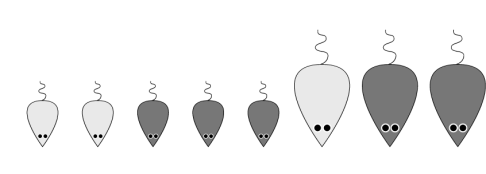A Biological Example

Figure 1 - Initial Population
Consider a simple example of evolution in the biological world (on a small scale). Here, “evolution” means any change in the distribution or frequency of genes in a population. Of course, the interesting thing about evolution is that it tends to lead to populations that are constantly adapting to their environments.
Specifically, consider a population of mice. These mice exhibit two sizes, small and large, and they exhibit two colors, light or dark. Our population consists of the following eight mice:
One day, cats move into the neighborhood and start eating mice. It turns out that darker mice and smaller mice are harder for the cats to find. Therefore, different mice have different odds of avoiding the cats long enough to reproduce. This affects the nature of the next generation of mice. Assuming the old mice die soon after reproducing, the next generation of mice looks like this:

Figure 2 - "Mid-Cat" Population
Notice that large mice, light mice, and especially large, light mice, are having trouble surviving long enough to reproduce. This continues in the next generation:

Figure 3 - "Post-Cat" Population
Now the population consists mostly of small, dark mice, because these mice are better suited for survival in this environment than other kinds of mice. Similarly, as the cats begin to go hungry with less mice to eat, perhaps those cats who prefer a lunch of grass will be better adapted, and pass along their grass-loving gene to a new generation of cats. This is the central concept of “survival of the fittest.” More precisely, it could be phrased “survival until reproduction.” In evolutionary terms, being the healthiest bachelor in the population is worthless because you must reproduce for your genes to influence future generations. i).genetic algorithms:a biological example;